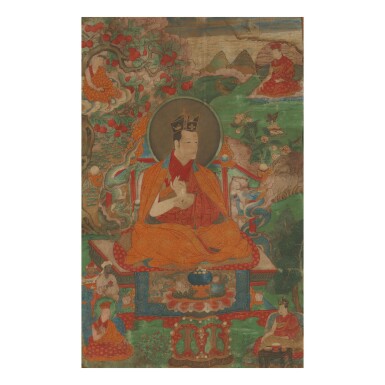Indian, Himalayan & Southeast Asian Works of Art
Indian, Himalayan & Southeast Asian Works of Art

PROPERTY FROM A RHODE ISLAND COLLECTION
A THANGKA DEPICTING THE 7TH KARMAPA, CHODRAK GYATSO, TIBET, 17TH CENTURY
Auction Closed
September 22, 07:46 PM GMT
Estimate
30,000 - 50,000 USD
Lot Details
Description
PROPERTY FROM A RHODE ISLAND COLLECTION
A THANGKA DEPICTING THE 7TH KARMAPA, CHODRAK GYATSO
TIBET, 17TH CENTURY
24 ½ by 15 ½ in. (62.2 by 39.4 cm)
the hierarch with hands in dharmachakra mudra, wearing red and saffron robes and the black hat of the Karma Kagyu lineage, seated on cushions set on a tiered pedestal draped with a blue bordered dragon motif textile, an altar table before with offerings, a blue and a green dragon writhing around the uprights of the jeweled throne back, all set in flower-filled landscape with a gnarled fruiting litchi tree to the left and mountains above, Jampal Gyatso with a rosary in hand and seated amid clouds to the upper left, Dondrup Ozer to the right, Tsultrim Pal Zangpo below with foreign pilgrims bringing gifts, and the eighth Karmapa Mikyo Dorje (1507-1554) seated in the lower right
Himalayan Art Resources item no. 13729.
Acquired in India, circa 1960s, thence by descent
The thangka is painted in a style ultimately derived from early Ming dynasty (1368-1644) imperial works depicting Luohan, where an arhat would be depicted wearing finely patterned silk robes and seated in landscape beneath a gnarled tree: cf. the Yongle (1403-1424) mark and period Chudapanthaka at Sotheby’s New York, September 21, 2007, lot 33 (HAR 12540). There is a stylistic resemblance to paintings attributed by David Jackson to Khyentse Chenmo of Gonkar — active mid to late fifteenth century — or his successors: details including the semi-transparent halo encircling Dondrup Ozer upper right, revealing background detail; rock formations and foliage; and finely executed Chinese Ming style textile designs are seen in the Three Great Adepts thangka in the Rubin Museum of Art, see David P. Jackson, A Revolutionary Artist of Tibet: Khyentse Chenmo of Gongkar, New York, 2016, p. 56, fig. 2.12 (HAR 65349). The present rare and finely executed portrait of Chodrag Gyatso (1454-1506) and lineage commemorates these earlier styles and dates to around the first half of the seventeenth century.
